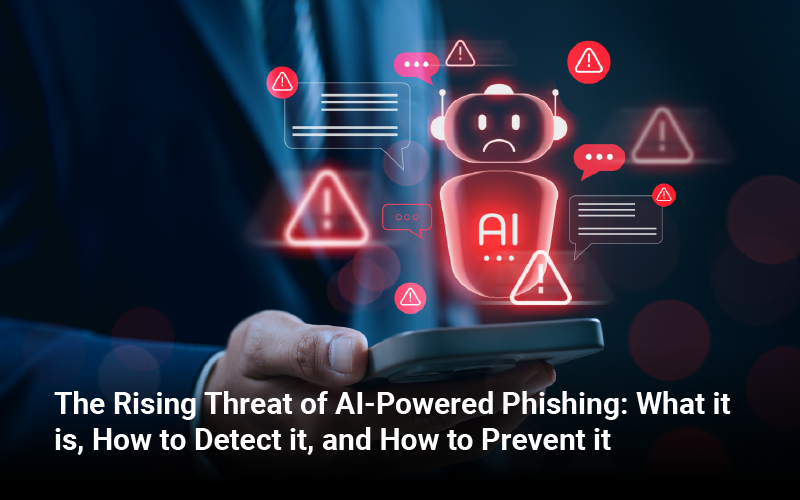Phishing has always been one of the most common and dangerous forms of cybercrime. But with artificial intelligence (AI) entering the picture, phishing scams are becoming smarter, faster, and harder to detect than ever before. Cybercriminals are now using AI tools to craft convincing emails, clone websites, mimic human behavior, and even generate realistic voices, intending to trick people into divulging sensitive information.
This article explores how phishing has evolved, how AI is reshaping the threat landscape, and how you can protect yourself and your organization from AI-powered phishing attacks.
An Overview of Phishing: Then and Now
Traditional phishing scams started with generic mass emails, often poorly written messages that claimed your “account was compromised” or you had “won a prize.” They relied on volume rather than sophistication. Most users could spot them easily because of obvious grammatical mistakes, suspicious links, and unusual sender addresses.
Over time, cybercriminals refined their tactics. They began using spear phishing (targeting specific individuals or organizations) and whaling (aiming at executives or high-value targets). Attackers learned to mimic legitimate company domains, logos, and branding.
Today, with the help of AI and ML (Machine Learning), phishing has reached an entirely new level of precision. Modern phishing emails can be personalized to the recipient, written in flawless language, and designed to evade even the most advanced spam filters.
How AI Supercharges the Sophistication of Phishing Scams
AI gives cybercriminals powerful new tools to make phishing attacks more believable and scalable. Here’s how:
- Natural Language Generation (NLG): Tools like ChatGPT or other AI models can create professional, grammatically correct, and contextually accurate messages that sound like real people or companies. What’s more, these tools can do this at a scale previously thought impossible, targeting scores of potential victims simultaneously.
- Voice Cloning: AI can replicate a company executive’s or loved one’s voice to request urgent financial transfers or personal information (a tactic known as vishing).
- Deepfake Videos: Attackers can fabricate convincing videos of real individuals to add authenticity to their scams.
- Data Analysis: Machine learning algorithms can analyze social media profiles, public data, and email patterns to customize attacks.
- Automation: AI enables large-scale phishing campaigns that adapt in real time, learning which messages get the best response and adjusting tactics accordingly.
In summary, AI enables scammers to do what used to take hours in mere minutes, with frightening accuracy.
Examples of AI Use Cases in Phishing Scams
AI-powered phishing is no longer theoretical. It’s a very real threat with dire consequences for those who fall prey to it. Here are a few examples of AI enhancing the scope of phishing scams:
- Deepfake CEO Scams: In 2024, several companies reported incidents where attackers used AI-generated voice calls impersonating their CEOs to request wire transfers. One European energy firm lost over $240,000 this way.
- Chatbot Impersonation: Cybercriminals now deploy AI chatbots on fake websites that mimic customer support from real companies, guiding victims into revealing login credentials or card details.
- Social Media Phishing: AI tools analyze LinkedIn or Facebook data to craft highly personalized phishing emails. Attackers might reference your job title, recent post, or connections to gain your trust.
- AI-Enhanced Email Spoofing: Some attackers use machine learning to study writing patterns of executives and send lookalike emails to employees, making it almost impossible to tell the difference.
These examples demonstrate how AI enables cybercriminals to exploit human psychology more precisely than ever before.
How to Detect an AI Phishing Scam Before It’s Too Late
Detecting AI phishing scams requires greater vigilance and critical thinking. Here are some telltale signs to look for:
- Unexpected Urgency or Emotional Triggers: Scammers often create a false sense of urgency (“Act now!” or “Your account will be locked!”).
- Inconsistencies in Tone or Style: Although AI writes fluently, it may overuse formal language or sound slightly off from what a real contact would write.
- Mismatched URLs and Email Addresses: Always hover over links before clicking. Check if the domain matches the legitimate company website.
- Requests for Confidential Information: Legitimate organizations rarely ask for passwords, PINs, or financial details over email or text.
- AI-Generated Voices or Videos: If a voice or video request seems slightly unnatural, confirm the request through another trusted channel.
- Metadata and Spelling Oddities: While AI improves grammar, it may still make factual or contextual mistakes (like referencing outdated information).
Preventing AI Phishing Scams: Precautionary Measures and Tools You Can Use
Stopping AI-powered phishing attempts requires a combination of human alertness and innovative technology. Here’s how to stay protected:
Individual-Level Measures
- Verify Before You Click: Double-check sender addresses and URLs. When in doubt, contact the sender directly using official contact channels.
- Use Multi-Factor Authentication (MFA): Even if scammers steal your password, MFA can stop them from accessing your accounts.
- Keep Software Updated: Regular updates fix security loopholes that attackers often exploit.
- Don’t Overshare Online: Limit what you post on social media, especially work details, travel plans, and personal information.
Organizational Measures
- Employee Awareness Training: Conduct regular phishing simulations and security awareness sessions.
- AI-Powered Email Security Tools: Use platforms like Microsoft Defender for Office 365, Proofpoint, or Barracuda Sentinel to detect suspicious patterns and language.
- Zero Trust Framework: Adopt a security model where no user or device is automatically trusted, even within the corporate network.
- Incident Response Plan: Ensure your organization has an uncomplicated process for reporting and handling phishing attempts.
Remember, the goal is not just to block phishing attacks, but to build a culture of cyber resilience.
Sharpen Your Cybersecurity Awareness to Stay Ahead of AI Phishing Scams
Knowledge is your best defense. Cybercriminals rely on human error, so staying alert and informed can render their phishing attempts unsuccessful. Here are a few good practices to strengthen your awareness:
- Stay updated on emerging cyber threats through credible sources like EC-Council, EC-Council University, or other authorized cybersecurity advisories.
- Enroll in cybersecurity awareness courses to understand modern cybersecurity threats and prevention techniques.
- Question unusual requests, even if they appear to come from trusted sources.
- Encourage a speak-up culture at work. Report suspicious emails without fear of blame.
Every click matters. One moment of caution can save your data, money, or your organization’s reputation.
Frequently Asked Questions About AI-Powered Phishing Scams
No. While big corporations are prime targets, individuals are equally at risk. Cybercriminals use AI to personalize attacks for anyone, from small business owners to everyday users.
Absolutely. Many cybersecurity tools now use AI to detect suspicious behavior, analyze email content, and identify anomalies faster and more accurately than humans can.
Immediately change your passwords, enable MFA, contact your bank if financial data was compromised, and report the incident to your organization’s IT or cybersecurity department if the scam occurred through company channels.
Use phishing simulation platforms or partner with cybersecurity education providers to deliver interactive awareness training sessions.
Unfortunately, yes. As AI becomes more powerful and accessible, phishing scams will evolve. However, awareness, vigilance, and advanced security tools will continue to be strong countermeasures.
For a balanced and nuanced view of the pros and cons of AI in cybersecurity, check out:







